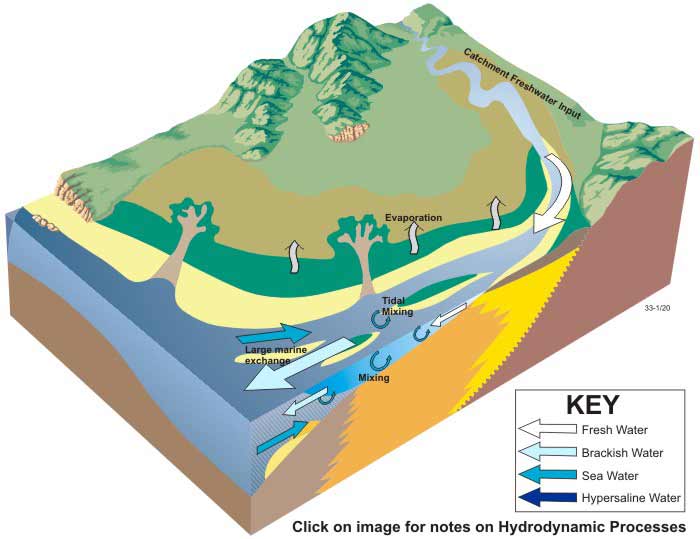
Hydrology processes in tide-dominated deltas
1. Catchment freshwater input
Freshwater enters from the catchment. Although the volume of freshwater input varies regionally and seasonally (depending on local catchment and climatic conditions), it is typically relatively high in most deltas.
2. Volume of freshwater
The volume of freshwater may cause significant stratification within the channel, which varies with seasonal flow. Buoyant low-salinity fresh water tends to float above denser, high-salinity marine water. High tidal ranges and turbulence associated with tidal currents tends to accelerate the mixing of freshwater and marine water.
3. Salt-wedge
A ‘salt-wedge’, or intrusion of denser saline marine water penetrates the delta through the wide entrance. Mixing occurs between less-dense freshwater, and higher-density marine water. The salt-wedge typically penetrates most of the deltaic system (due to a large tidal prism and tidal amplification). The distance that the salt-wedge penetrates into the delta depends on the fluvial flow rate and tidal range (Kurup et al., 1998, Wolanski, 1986b). Current flow in channels is quite strong, due to a small cross-sectional area, and the residence time of water (the time taken for water to travel through the delta) is typically short. During periods of extreme flow the freshwater can push the salt water seaward, beyond the mouth.
4. Marine and freshwater exchange
Exchange occurs through the wide entrance of the delta. Tide-dominated deltas are generally well-flushed, featuring a tidal prism that can be several orders of magnitude larger than the volume of freshwater input by rivers. As a consequence, lower salinity water occurs towards the head of tide-dominated delta due to the direct influence of the river, whereas the lower reaches and the entrance typically contain water with salinities approaching that of the open ocean. Flood and ebb tides may follow different routes into and out of the delta, and the tidal prism tends to be large. Except during flood conditions, the volume of freshwater is typically small in comparison to the large volume of the tidal prism (Heap et al., 2001).
5. Delta-top environments
Delta-top environments (low elevation marshes) are subject to tidal influence, and the channels are subject to either reverses in flow or periods of stagnation as a flood tide balances the fluvial discharge. Overbank areas on the delta top may be more subject to flooding during periods of high fluvial discharge coupled with high tides (Nichols 1999). Saltflats environments are inundated rarely (e.g. 3-4 days per month), resulting in hypersaline groundwaters and often a saline crust on the surface (Ridd et al., 1997).
6. Evaporation
Evaporation is a significant process in tide-dominated deltas due to the extensive intertidal area (also depending on climatic conditions), however does not exceed freshwater river input.


